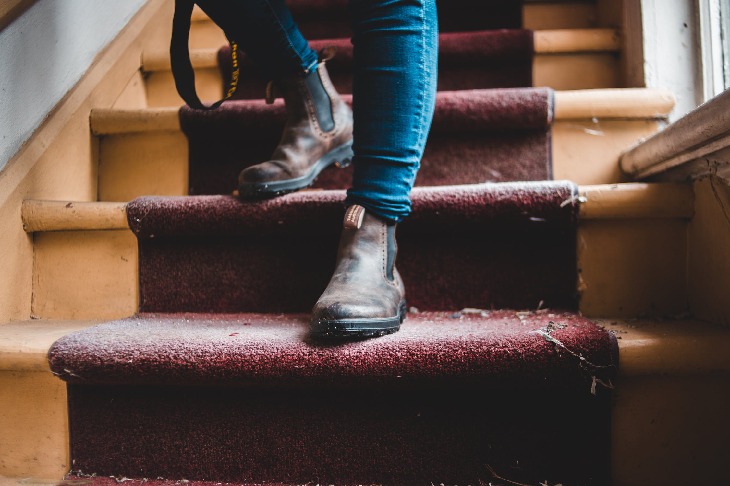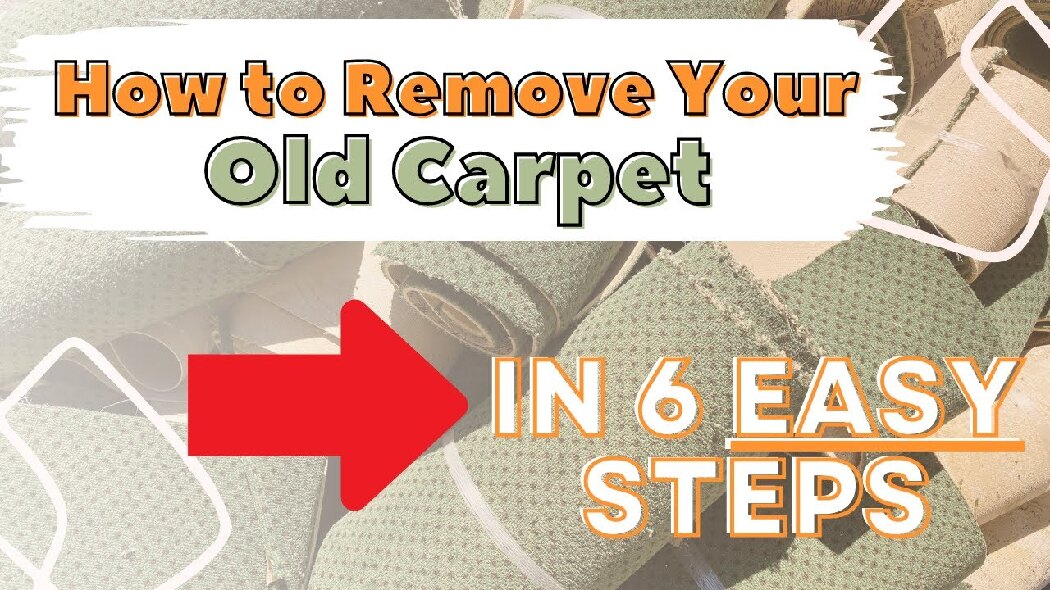After years of use and many ambitious deep cleanings, you might be ready to part ways with your carpet flooring because it’s too high maintenance. It’s time to think about removing the carpet. Choosing to remove carpet yourself is a cost-effective alternative to hiring professionals, allowing you to save money while tackling the project on your own. Carpets are available in many colors, textures, and styles; but they’re also prone to attracting dirt, debris, and various allergens. Learn how to get rif of old, worn-out carpet from your home before installing brand new floors with this step-by-step guide.
The Disadvantages of Carpet
For homeowners who live in colder parts of the country, carpet can add comfort by keeping their feet warm during the winter. However, it might be easier to have a different type of flooring, such as hardwood, tile, or laminate, if you have multiple pets or a member of your family has severe allergies, or perhaps you’re updating a high traffic area such as a mudroom. Depending on the size of your home and your lifestyle, maintaining carpet can be a full-time job, and you may have to deal with the following:
- Excessive pet hair
- Unwanted moisture and mold growth
- Trapped odors
- Debris buildup
If you’re planning on switching to a new type of flooring, you can remove carpet yourself before having professionals install your new floors. Proper removal is essential to ensure a smooth carpet installation or installation of other flooring types. Use the following guide and DIY checklist to safely dispose of old carpeting.

Clear Out Old Carpet With Ease
Rent a dumpster to make disposal fast and efficient—no more piles of carpet and padding cluttering your space!
Getting Started: The Supplies and Tools Needed for Removing Carpet
You'll get the most value out of this DIY project by doing it right the first time. Save money and avoid any potential complications by taking the necessary steps to ensure a safe and thorough removal of your old carpet. By investing in the proper tools to remove carpet, such as a carpet knife, pry bar, and carpet stretcher, which typically won't exceed $150 in cost, you'll be equipped with everything you need to tackle this task efficiently. Not only will this save you from the expense of hiring a contractor, but it will also give you the satisfaction of accomplishing the project on your own while maintaining a reasonable budget.
- Pry bar
- Utility knife
- Hammer
- Duct tape
- Locking pliers
- Floor scraper
- Dust masks
- Knee pads
- Safety glasses
- Work boots
Do not attempt to remove your carpet without the appropriate protective equipment. Carpets sit on top of sharp tack strips and have abrasive backings that can cause injuries.
To ensure your safety during the removal process, it is crucial to wear heavy-duty work gloves, safety goggles, and knee pads. These protective gears, along with the necessary tools to remove carpet, will shield your hands from potential cuts and punctures, safeguard your eyes from flying debris, and provide cushioning for your knees as you work on the floor.
Additionally, wearing a dust mask is recommended to prevent inhaling dust and allergens that may be stirred up during the removal. By prioritizing your safety with the right equipment, including the essential tools to remove carpet, you can confidently tackle the carpet removal while minimizing the risk of accidents and ensuring a smooth and successful DIY project.
Safety Precautions Before You Begin
Before you dive into your carpet removal project, taking the right safety precautions is crucial for a smooth and injury-free removal process.
Start by gearing up with essential safety equipment: wear sturdy gloves to protect your hands from sharp objects and abrasive carpet edges, and always use safety goggles to shield your eyes from flying debris. A dust mask is a must-have to prevent inhaling dust and allergens that get stirred up during the removal. Don’t forget knee pads—your knees will thank you after hours spent working on the floor.
Make sure you have all the proper carpet removal tools on hand, such as a utility knife, floor scraper, and pry bar, to avoid damaging the subfloor or surrounding areas. Before you begin, clear the room of all furniture and cover any items that can’t be moved with plastic sheeting to protect them from dust and debris.
Keep a first aid kit nearby and have a phone within reach in case of emergencies when utilizing carpet removal tools. By preparing your workspace and using the right safety gear, you’ll protect yourself and your home, making the carpet removal process safer and more efficient.
Step-By-Step Guide to Remove Your Old Carpet
Step 1. Start the removal project by pulling on the corner of a room's carpet. It's important to do this with gloves on because of the staples in the subfloor and the tack strip, which are lined with tacks or nails. If your carpet is relatively new and can't be pulled easily, use the utility knife to rip up a corner and pull an edge free. Cut larger sections as you go to pull the carpet up faster.
Dealing with Underlayment
When removing carpet, you’ll often find a layer of underlayment—commonly called carpet padding or carpet pad—between the carpet and the subfloor. This padding is usually made from foam, rubber, or fiber, and its main job is to add comfort and extend the life of your carpet.
To remove it, start by cutting the carpet pad into manageable sections with a utility knife. This makes it easier to handle and dispose of.
If the carpet padding is stapled down, use pliers to pull out the staples as you go. For glued-down padding, a floor scraper or pry bar will help you gently lift the material without damaging the subfloor.
Work slowly and carefully to avoid gouging the floor, especially if you plan to install new flooring like hardwood or laminate. Once all the padding is removed, inspect the subfloor for any leftover adhesive, staples, or debris. Clean the area thoroughly to ensure a smooth surface before installing your new flooring.
Taking the time to remove and dispose of the underlayment properly will help your new floors look and perform their best.
Handling Tack Strips
Tack strips are thin pieces of wood lined with sharp tacks that keep your carpet securely in place along the edges of the room. When removing carpet, it’s essential to handle these tack strips with care to avoid injury and prevent damage to your subfloor. Start by using a pry bar to gently lift the tack strip away from the floor—work slowly to avoid pulling up chunks of wood or damaging the subfloor beneath.
Some tack strips or transition strips may be fastened with screws, so use a screwdriver or the appropriate carpet removal tools to remove them safely.
Once the tack strip is loose, use pliers to remove any remaining tacks or nails. If you come across tack strips that are rusted, broken, or splintered, it’s best to remove them completely to prevent future issues when installing new flooring.
For more straightforward disposal, use a utility knife to cut the tack strips into smaller pieces. After all the tack strips are removed, inspect the subfloor for any stray tacks or debris and clean the area thoroughly. Properly handling tack strips not only keeps you safe but also ensures that your new flooring has a solid, smooth foundation.
Preparing for New Flooring Installation
Once you’ve cleared the space, it’s time to plan for the new flooring installation. Whether you’re adding tile, laminate, or hardwood floors, make sure the subfloor is clean, smooth, and dry. Some homeowners opt for professional installation, but handy DIYers can also take this on with careful planning.
Flooring Installation Tips
When installing new flooring, preparation is key to a successful project. Start by making sure your subfloor is clean, dry, and level—this will help your new flooring lay flat and last longer. Always follow the manufacturer’s instructions for your chosen flooring type, whether it’s hardwood, laminate, tile, or carpet. Use the right carpet removal tools for the job, and take your time to measure and cut materials accurately for a professional look. If you’re working with planks or tiles, stagger the seams for added strength and visual appeal. Don’t forget to leave the recommended expansion gaps around the edges, especially for wood and laminate floors. With careful planning and attention to detail, your new flooring installation will look great and stand the test of time.
Cleaning and Preparing the Subfloor
With the carpet, padding, and tack strips out of the way, it’s time to focus on cleaning and preparing the subfloor for your new flooring installation.
Begin by sweeping or vacuuming the entire floor to remove dust, debris, and any leftover adhesive. For a deeper clean, use a damp mop—just be careful not to saturate wood subfloors, as excess moisture can cause warping. If you’re working with a concrete subfloor, a specialized concrete cleaner can help remove stubborn residue.
Once the subfloor is clean, inspect it closely for any signs of damage, such as cracks, uneven spots, or lingering staples. Make any necessary repairs to ensure the surface is smooth and level. Use a floor scraper to remove any remaining bumps or adhesive, creating an even base for your new flooring.
Taking the time to properly clean and prepare the subfloor will help prevent future problems and ensure your new carpet, hardwood, laminate, or tile flooring looks great and lasts for years to come.
Removing Carpet From Your Stairs
Removing carpet from a staircase is a similar process, but there will be a bit more repetition:
- While wearing gloves, cut the carpet with the utility knife near the risers, which are the vertical planks between each step. Remove and collect the staples and tacks used to secure the carpet as you progress.
- If there's metal nosing at the head of the stairs, use the pry bar to remove it before pulling up the carpet. As you work your way down, cut the carpet into strips so that you can roll up each section and put it aside.

How to Dispose of Your Old Carpet
Getting rid of the old materials will be easier and faster if you roll up and tape the discarded strips of carpet and carpet padding. If you don't know whether your local garbage collection service will get rid of these materials, consider renting a dumpster to ensure a speedy cleanup. You can toss everything into the dumpster, including the tack strips, and if you happen to have old couches or furniture, you can take advantage and toss that too! If your carpet isn't the only flooring that needs an update, take a look at our guide on removing ceramic floor tiles.
With the proper tools, you can get any home renovation done easily, including removing your old carpet. Like with any renovation, you're bound to have a ton of debris left over that you'll need hauled away.
Tips for a Smooth Project
Before you start, measure the square footage of the rooms you’re working on. This helps you estimate how much time, labor, and dumpster space you’ll need. Plan ahead to cover doorways and vents, have your tools ready, and wear all recommended protective gear.
Bin There Dump That offers an array of Residential Friendly dumpsters that can be conveniently scheduled for pick-up and drop-off at your convenience. We offer affordable pricing for rentals used for full-home carpet removals, as well as excellent customer service. We've worked with homeowners across the United States to help them complete a wide variety of renovation projects, including removing carpet from their homes. To schedule a roll off dumpster rental, find a Bin There Dump That location near you.
Tearing Out Carpet? Make Cleanup Easy.
Request a dumpster to handle the mess—perfect for hauling away old carpet, padding, tack strips, and other debris from your flooring project.

